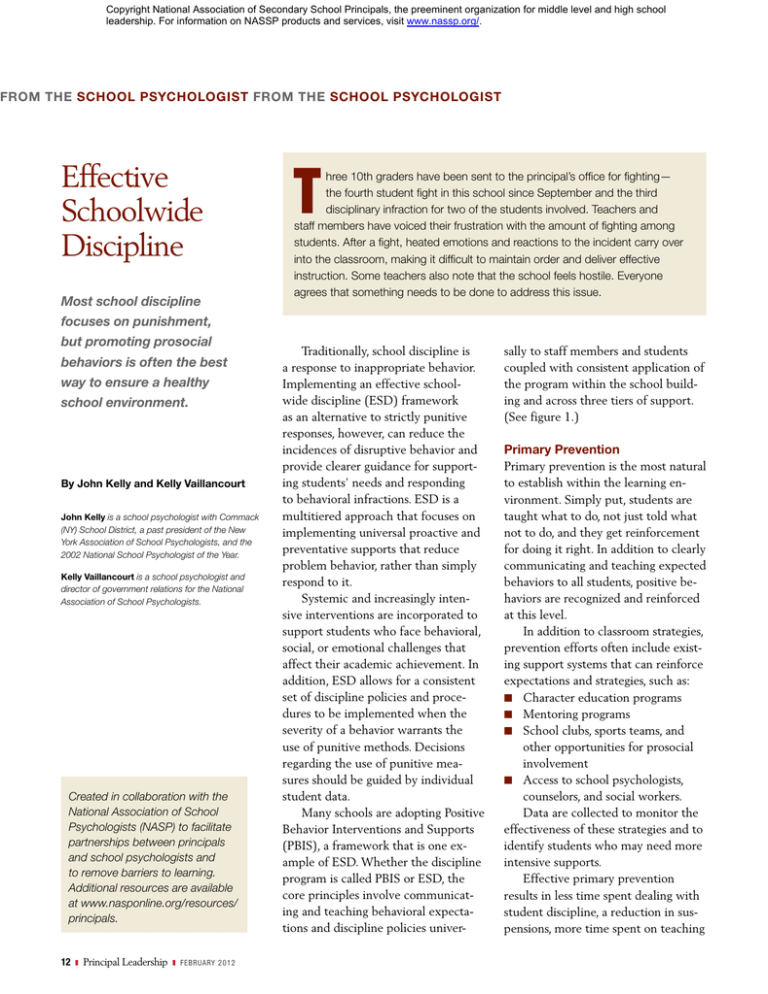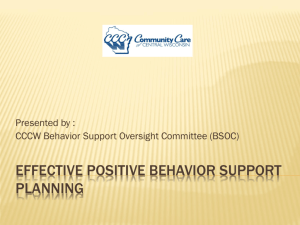Effective Schoolwide Discipline from the
advertisement

Copyright National Association of Secondary School Principals, the preeminent organization for middle level and high school leadership. For information on NASSP products and services, visit www.nassp.org/. from the school psychologist from the school psychologist Effective Schoolwide Discipline Most school discipline T hree 10th graders have been sent to the principal’s office for fighting— the fourth student fight in this school since September and the third disciplinary infraction for two of the students involved. Teachers and staff members have voiced their frustration with the amount of fighting among students. After a fight, heated emotions and reactions to the incident carry over into the classroom, making it difficult to maintain order and deliver effective instruction. Some teachers also note that the school feels hostile. Everyone agrees that something needs to be done to address this issue. focuses on punishment, but promoting prosocial behaviors is often the best way to ensure a healthy school environment. By John Kelly and Kelly Vaillancourt John Kelly is a school psychologist with Commack (NY) School District, a past president of the New York Association of School Psychologists, and the 2002 National School Psychologist of the Year. Kelly Vaillancourt is a school psychologist and director of government relations for the National Association of School Psychologists. Created in collaboration with the National Association of School Psychologists (NASP) to facilitate partnerships between principals and school psychologists and to remove barriers to learning. Additional resources are available at www.nasponline.org/resources/ principals. 12 z Principal Leadership z fe br uary 2012 Traditionally, school discipline is a response to inappropriate behavior. Implementing an effective schoolwide discipline (ESD) framework as an alternative to strictly punitive responses, however, can reduce the incidences of disruptive behavior and provide clearer guidance for supporting students’ needs and responding to behavioral infractions. ESD is a multitiered approach that focuses on implementing universal proactive and preventative supports that reduce problem behavior, rather than simply respond to it. Systemic and increasingly intensive interventions are incorporated to support students who face behavioral, social, or emotional challenges that affect their academic achievement. In addition, ESD allows for a consistent set of discipline policies and procedures to be implemented when the severity of a behavior warrants the use of punitive methods. Decisions regarding the use of punitive measures should be guided by individual student data. Many schools are adopting Positive Behavior Interventions and Supports (PBIS), a framework that is one example of ESD. Whether the discipline program is called PBIS or ESD, the core principles involve communicating and teaching behavioral expectations and discipline policies univer- sally to staff members and students coupled with consistent application of the program within the school building and across three tiers of support. (See figure 1.) Primary Prevention Primary prevention is the most natural to establish within the learning environment. Simply put, students are taught what to do, not just told what not to do, and they get reinforcement for doing it right. In addition to clearly communicating and teaching expected behaviors to all students, positive behaviors are recognized and reinforced at this level. In addition to classroom strategies, prevention efforts often include existing support systems that can reinforce expectations and strategies, such as: n Character education programs n Mentoring programs n School clubs, sports teams, and other opportunities for prosocial involvement n Access to school psychologists, counselors, and social workers. Data are collected to monitor the effectiveness of these strategies and to identify students who may need more intensive supports. Effective primary prevention results in less time spent dealing with student discipline, a reduction in suspensions, more time spent on teaching and learning, and improved student achievement and graduation rates (e.g., Illinois PBIS Network, 2006; Washburn, Stowe, Cole, & Robinson, 2007). Secondary and Tertiary Supports Students requiring secondary or tertiary interventions often have patterns of behavior that impede their learning and require a disproportionate amount of the staff members’ time and energy to deal with. Those students have higher rates of academic failure, poor attendance, poor relationships with teachers, and higher rates of dropping out of school than their peers (e.g., Allensworth & Easton, 2005; Alliance for Excellent Education, 2010; Balfanz & Herzog, 2005). Incorporating effective support systems in schools can provide those students with the strategies and tools that will build their academic and social skills. Relying on a reactive approach to problem behaviors often results in lost instruction time. Research indicates that interventions that strengthen students’ social, emotional, and decision-making skills also positively affect their academic achievement in terms of higher standardized test scores and better grades (e.g., ­Irvin, Tobin, Sprague, Sugai, & Vincent, 2004). Holding students accountable for their choices is important, but those consequences should be fair, consistent, and proportionate to the infraction, and they always should be integrated with learning supports. Secondary Interventions Secondary supports give students who are inconsistent in meeting academic or behavioral standards slightly more individualized instruction or support. Students requiring this level of support may have failed more than two classes, have excessive tardiness or absence violations, or frequently cause classroom disruption. The goal of secondary supports is to prevent at-risk behaviors from escalating or becoming chronic. Secondary supports often include progress monitoring to assess students’ response to academic or behavioral interventions. Some interventions are delivered in a small-group setting but many are implemented in the classroom with support from the school psychologist or other staff members. Tertiary Interventions Tertiary supports provide intensive, individualized instruction and support for a specific set of behaviors. Students requiring this level of support may have challenges on multiple levels, such as mental health needs, difficulties at home, or involvement in the juvenile justice system. Such students are most at risk for failing, dropping out, or engaging in criminal activity (e.g., Allensworth & Easton, 2005; Alliance for Excellent Education, 2007; Balfanz & Herzog, 2005). Implementing tertiary supports can be challenging, but their effectiveness should not be underestimated. The goal is to keep students in the classroom and engaged in learning, even if they must receive intense interventions during the school day. Those interventions can be delivered by putting a support person in the classroom to address the needs of the student or by removing the student from the classroom for brief periods to receive individual counseling or support. Although removing students from class is a last resort, it can be necessary to reengage them in mean- Students requiring secondary or tertiary interventions often have patterns of behavior that impede their learning and require a disproportionate amount of the staff members’ time and energy to deal with. f e b r u a ry 2 0 1 2 z Principal Leadership z 13 from the school psychologist from the school psychologist Tertiary supports ameliorate severe or chronic behaviors that impede a student’s progress in and out of school. Effective tertiary supports require the knowledge and collaboration of specialized instructional support personnel (e.g., school psychologists and school social workers) with teachers and administrators. 14 z Principal Leadership z fe br uary 2012 ingful learning. Students who have severe mental health or behavioral needs simply will not learn to their fullest potential without individualized support. The process of providing tertiary supports varies at each school. It is important to involve specialized instructional support personnel (e.g., a school psychologist or a social worker) to be a part of the leadership team that designs this system. Suggestions for Implementation An effective secondary support is Check-in/Check-out (CICO). Students receiving this support have a small number of behavioral and social goals that they are striving to meet. They check in with an adult in the building when they arrive at school to review their goals for the day and check out before leaving school to discuss their daily performance. The goal of CICO is to start the day on a positive note and establish and reinforce behavioral expectations for the student. The day is concluded with a review of data (often collected by the student) on the student’s behavior in class. This provides an opportunity to correct problem behaviors and reinforce prosocial behaviors. Skill-building groups are another common secondary intervention that is easy to implement and does not require the student to miss a significant amount of instruction. Those groups teach, model, and reinforce a specific set of skills (e.g., social skills, anger management, or decision making) and can meet during the lunch hour or on a rotating schedule to ensure that the student is not consistently being removed from the same class. Specialized instructional support personnel should be involved in providing these groups. Tertiary supports ameliorate severe or chronic behaviors that impede a student’s progress in and out of school. Effective tertiary supports require the knowledge and collaboration of specialized instructional support personnel (e.g., school psychologists and school social workers) with teachers and administrators. Students who do not respond to secondary interventions receive a functional behavior assessment to analyze the specific behaviors and to design individualized support strategies. This assessment is developed by a team that identifies the underlying causes of the behavior so that the most effective intervention can be developed. There is no onesize-fits-all approach, but having the necessary personnel available to design individualized and intensive supports is a universal step. Examples of tertiary supports include individualized behavior plans, access to individualized counseling services with the school counselor or school psychologist, and coordinated wraparound care facilitated by the school social worker. Wraparound services are distinguished from traditional service delivery in special education and mental health by their focus on connecting families, schools, and community partners in effective problemsolving relationships. Students requiring this level of intervention usually need individualized support in the classroom or need to receive instruction in a more restrictive environment. The Principal’s Role First, the most effective form of leadership in developing an ESD framework often is establishing an effective and efficient team of school personnel who will guide practices at all three tiers. Top 10 Tips for Administrators 1 2 3 4 5 6 7 8 Establish a representative leadership team to lead implementation of an ESD framework. Make positive, personal connections with all students. Maintain consistent standards regarding which interventions the school will employ. Publicly support the implementation plan and give team members the necessary time and resources to accomplish it. Tertiary Students at high risk of failure Intensive Individualized Provide recognition to faculty and team members for their hard work. Serve as the spokesperson to community stakeholders about the worth and importance of the schoolwide supports. Maintain a continuum of procedures for encouraging expected behavior and discouraging inappropriate behavior. 10 Guide, not do not dictate, decision making. Figure 1 9 Regularly attend and participate in team meetings. Maintain procedures for data collection, ongoing monitoring, and decision making. Individualized plans; intensive academic supports; functional behavior assessment; multiagency collaboration Secondary Students with some risk factors Targeted prevention of specific challenges Individual and group settings Skill building groups; increased academic supports; social-emotional compentency training; self-management training Primary All students in all settings Schoolwide support systems Development of protective factors Academic supports; instruction in behavioral expectations; classroom management; positive reinforcement; firm, fair discipline Adapted from information on PBIS.org f e b r u a ry 2 0 1 2 z Principal Leadership z 15 from the school psychologist from the school psychologist Case Example of Tier One Supporting Tiers Two and Three A primary characteristic of an effective ESD framework is that the tiers support one another in creating a healthy school environment. The three high schools in Springfield SD 186 in Illinois exemplify how tier one fidelity can increase as tier two and three structures are being developed. Each of the schools has an active PBIS secondary systems team, which has begun using the tiers two and three Systems Guiding Questions tool to help them design, implement, and refine the tier two structure. As the tier two interventions were implemented and more students received support, a decrease in out of school suspensions was observed—in fact, the rate from August through November decreased by 44% (from 1,115 events in 2009–10 to 629 in 2010–11). 16 Second, the level of student connectedness to school is a strong predictor of student success. Many students with behavioral and discipline issues have a negative view of school and often associate the principal with punishment. Reaching out to these students in a supportive and encouraging manner will send the message that they are cared about and that their principal shares the common goal of healthy development and success in life for them. Third, data is a powerful tool, and highlighting success will help sustain implementation of an ESD framework. Current and accurate data about individual students, class progress, and schoolwide programs help ensure more effective and efficient decisions and solutions. The principal does not need to be the data manager, but the effective use of data should be part of his or her decision making and communication. Effective data collection guides the reinforcement of positive, prosocial behaviors as well as changes in intensity of student interventions. Finally, data can be used to recognize students and staff members for the things that they are doing well and to identify which areas need improvement. Source: Illinois PBIS Network Next Steps (www.pbisillinois.org) Implementing an ESD framework does not require that you work harder, but rather that you work smarter. Examine your school organization system and identify programs or systems currently in place to support at-risk students. Build on those existing supports and determine how you can better coordinate the efforts of existing student support teams to more effectively and efficiently meet the needs of all of your students. z Principal Leadership z fe br uary 2012 Conclusion As the school leader, the principal establishes the climate for staff members, students, and community members within the school. Responding to the needs of students and staff members is essential in establishing a safe and supportive learning environment. ESD allows the principal to address those needs in a systematic manner that focuses on student learning and success, rather than ineffective punishment. PL References n Allensworth, E. M., & Easton, J. Q. (2005). The on-track indicator as a predictor of high school graduation. Chicago, IL: Chicago Consortium on Chicago School Research. n Alliance for Excellent Education. (2010). High school dropouts in America (Fact sheet). Retrieved from http://www .all4ed.org/files/HighSchoolDropouts.pdf n Balfanz, R., & Herzog, L. (2005). Keeping middle grades students on-track to graduation: Initial analysis and implications. Presentation at the second Regional Grades Symposium, Philadelphia. n Illinois PBIS Network. (2006). Illinois PBIS Network end of year report: FY 06. Retrieved from http://docs2.pbisillinois .org/Online_Library/Downloads/Reports/ FY06_Short_Rpt.pdf n Irvin, L., Tobin T., Sprague, J., Sugai, G., & Vincent, C. (2004). Validity of office discipline referral measures as indices of schoolwide behavioral status and effects of school-wide behavioral interventions. Journal of Positive Behavior Interventions, 6(3), 131–147. n Washburn, S., Stowe, K. J., Cole, C. M., & Robinson, J. (2007). Improving school climate and student behavior: A new paradigm for Indiana schools. Education Policy Briefs, 5(9). Retrieved from http://ceep. indiana.edu/projects/PDF/PB_V5N9 _Fall_2007_EPB.pdf






